What Is a Marketing Plan?
A marketing plan is a comprehensive document that outlines the marketing strategies and tactics a business uses to promote its products, services, or brand to its target audience. It also includes information like target market, value proposition, proposed marketing campaigns, and success metrics.
To create a successful marketing plan, you need to conduct thorough market research.
This helps you understand your market, target audience, competitors, and industry trends. With these insights, you can create customer-focused marketing campaigns that get results.
As you create a marketing plan, the Semrush .Trends toolkit can speed up your market research process. It features multiple market intelligence tools like:
- Market Explorer: Get an instant overview of your market
- One2Target: Understand your target audience and how they engage online
- EyeOn: Track your competitors’ online marketing activities
- Traffic Analytics: Analyze your competitors’ traffic sources, stats, and growth strategies
We’ll talk more about using tools for market research later in the article. For now, let’s discuss why marketing plans are important for businesses.
Why Do You Need a Marketing Plan?
An effective marketing plan leads to more targeted marketing efforts. This can result in increased sales and greater brand visibility in your target market.
Here are some more reasons why you need a marketing plan for your business:
- Provides clear direction: A marketing plan provides guidelines for your marketing activities. For example, it outlines the goals, strategies, and tactics you need to implement to achieve specific objectives. This helps your marketing team understand what they need to do and why.
- Ensures alignment with business goals: A well-developed marketing plan ensures that marketing goals align with the overall business objectives.
- Allows efficient resource allocation: A marketing plan helps allocate resources—financial, human, and time—effectively. For instance, you can allocate more resources to strategies and activities that maximize return on investment.
- Enables targeted marketing approach: To create an effective marketing plan, you need to define your target audience. And understand their needs, preferences, and pain points. This way, you can create more targeted and personalized marketing campaigns that resonate with your ideal customers.
- Helps with performance measurement: An ideal marketing plan also defines benchmark metrics and key performance indicators (KPIs) to measure the success of your marketing activities. It helps you identify what’s working well. And what needs improvement.
- Ensures a consistent brand message: You can maintain consistency in your brand’s voice across different channels—like email, social media, website, and podcasts—by providing the marketing plan to your different marketing teams.
Marketing Plan vs. Marketing Strategy vs. Business Plan
A marketing plan is often confused with a marketing strategy. Or a business plan.
But they’re not the same.
Each one plays a different role in the overall success of a business.
Let’s consider the differences between the three.
|
Business Plan |
Marketing Strategy |
Marketing Plan |
|
|---|---|---|---|
|
What It Is |
A comprehensive document outlining the overall business strategy, goals, and action plan |
A document detailing how a business engages its audience, conveys value, and drives sales |
A tactical document outlining marketing tasks, schedules, and resources to achieve marketing goals |
|
Key Elements |
Business goals, financial projections, market analysis, and strategic planning |
Target market analysis, brand positioning, competitive differentiators |
Campaigns, budgets, timelines, specific marketing channels, and success metrics |
|
Purpose |
To guide overall business strategy, including financial planning and operational strategy |
To set the direction and goals for marketing efforts, informing resource focus |
To implement the overarching marketing strategy with actionable steps |
Here’s an example to help make the differences clearer:
A pet supplies startup aims to become a leader in eco-friendly pet products.
Their business plan highlights the startup’s mission to cater to eco-conscious pet owners. By offering sustainable products like biodegradable toys and organic pet food.
It also includes financial projections, market analysis, and competitive analysis.
Their marketing strategy focuses on establishing the brand as eco-friendly and health-conscious. The strategy is to:
- Target environmentally conscious pet owners
- Position the brand as a provider of high-quality, sustainable pet supplies
- Build awareness through green partnerships and educational content on sustainable pet care
To implement this strategy, their marketing plan includes:
- Social media campaigns: Regularly showcasing products and sustainable pet care tips on platforms like Instagram and Facebook
- Content marketing: Weekly blog posts on their website covering topics like “Eco-friendly Pet Care”
- Email marketing: Newsletters to an email list of eco-conscious pet owners—featuring product updates and pet care tips
- Community engagement: Participating in local eco-friendly pet events and partnerships with influencers
- Paid advertising: Google Ads and social media ads targeting eco-conscious pet owners
Types of Marketing Plans
You can tailor marketing plans based on your goals, channels, and strategies.
For example:
A small business that uses only one or two marketing channels may only need one marketing plan. But if you have complex marketing needs, you may require multiple plans.
Let’s go over some of the most common types of marketing plans.
|
Type of Marketing Plan |
Key Aspects |
|---|---|
|
Quarterly or Annual Marketing Plan |
|
|
Content Marketing Plan |
|
|
Social Media Marketing Plan |
|
|
Product Launch Marketing Plan |
|
|
Growth Marketing Plan |
|
Quarterly or Annual Marketing Plans
A quarterly or annual marketing plan is a high-level plan highlighting the marketing activities for the upcoming quarter or year.
It’s the simplest and most popular type. Especially for giving an overview of the proposed marketing plan to stakeholders.
You can also briefly mention your channel-specific marketing plans in your quarterly or annual plan.
Quarterly plans revolve around your short-term business goals. And the annual marketing plan caters to your medium and long-term goals.
For example, if you are a clothing retailer, your quarterly marketing plan may include strategies such as:
- Launching new product lines
- Running promotional campaigns
- Leveraging social media influencers
And so on …
These high-level plans ensure your marketing efforts are cohesive. And aligned with your overall business goals.
Content Marketing Plans
Content marketing is about leveraging content to reach your target audience. And achieve your business goals.
A content marketing plan highlights the specific channels and audiences you want to target with your content. It also includes different strategies, campaigns, or tactics you’ll use to attract and engage customers.
You can also add a content calendar. This outlines the topics, formats, and distribution channels for your content.
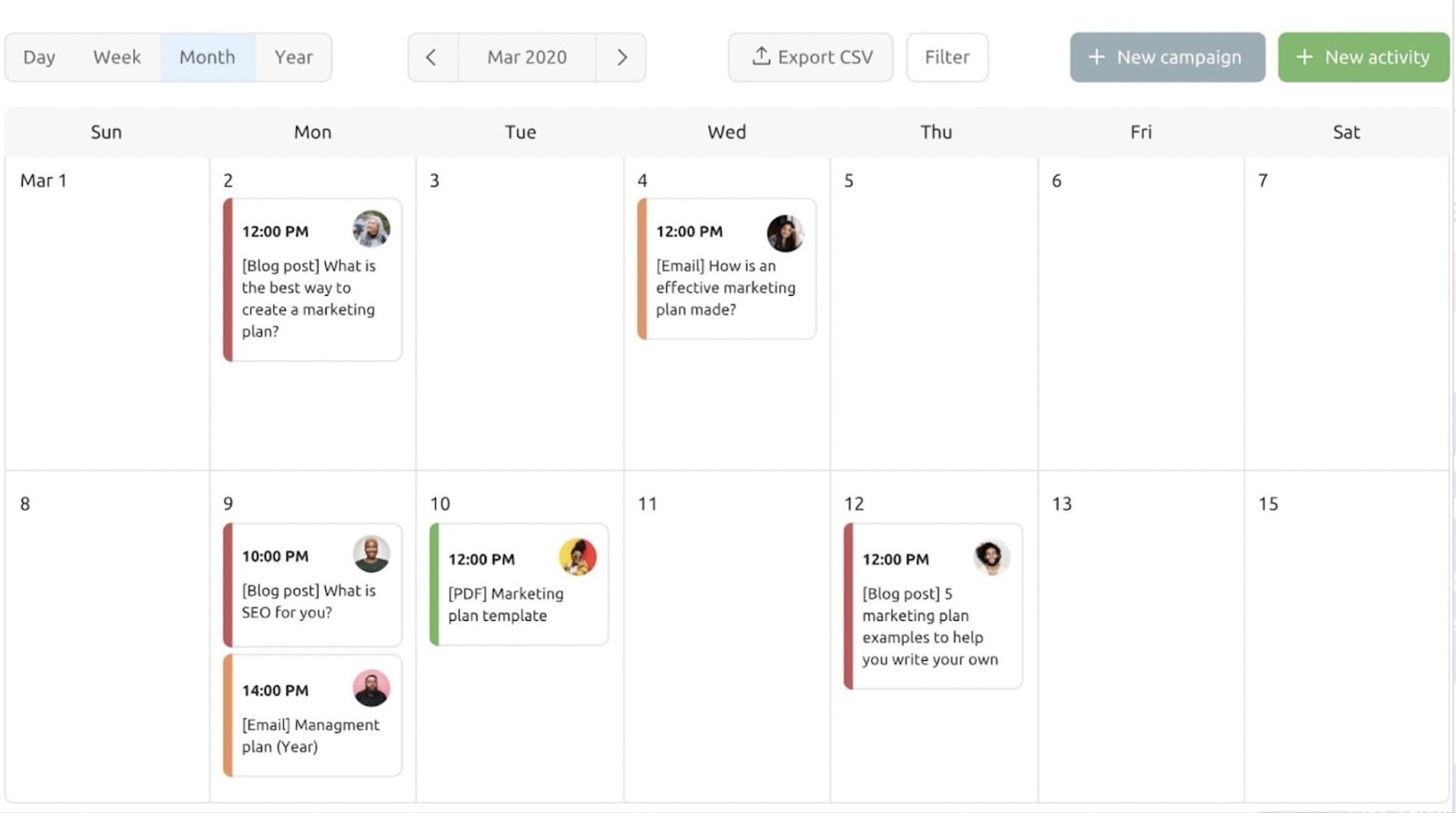
It helps you effectively manage your content production and publishing schedule. This way, your content efforts stay aligned with your content strategy and overall marketing objectives.
Further reading: 15 Effective Content Marketing Tips to Skyrocket Your Results
Social Media Marketing Plans
A social media marketing plan communicates how you’ll achieve your marketing goals with social media specifically.
It typically includes:
- Your social media marketing goals and KPIs (increase brand awareness, grow your follower count, lead generation, etc.)
- Your social content strategy, including types of content, posting frequency, and content repurposing guidelines
- The social media platforms you intend to use for marketing
- Engagement plan (tactics to make your audience engage more with your content)
- Social media marketing budget
- Details of social media team (names, responsibilities, and deliverables)
Product Launch Marketing Plans
These plans are specifically tailored for introducing a new product to the market. They guide the positioning, pricing, and promotion of a new product or service.
Here, the key is to create a sense of excitement and urgency. This ensures your product makes a significant impact upon its release.
You can achieve this by:
- Determining the right channels for reaching the intended audience
- Generating buzz and anticipation before the launch
- Creating targeted messaging to highlight the product’s unique value proposition
- Leveraging a mix of public relations, social media campaigns, influencer partnerships, and event marketing
Further reading: 15 Creative Product Launch Ideas to Ignite Your Brand’s Growth
Growth Marketing Plans
A growth marketing plan takes a broad approach that targets the entire marketing funnel. Growth marketing plans rely heavily on experiments and data analysis to drive growth.
Here, the main focus is identifying optimization opportunities at all customer touchpoints.
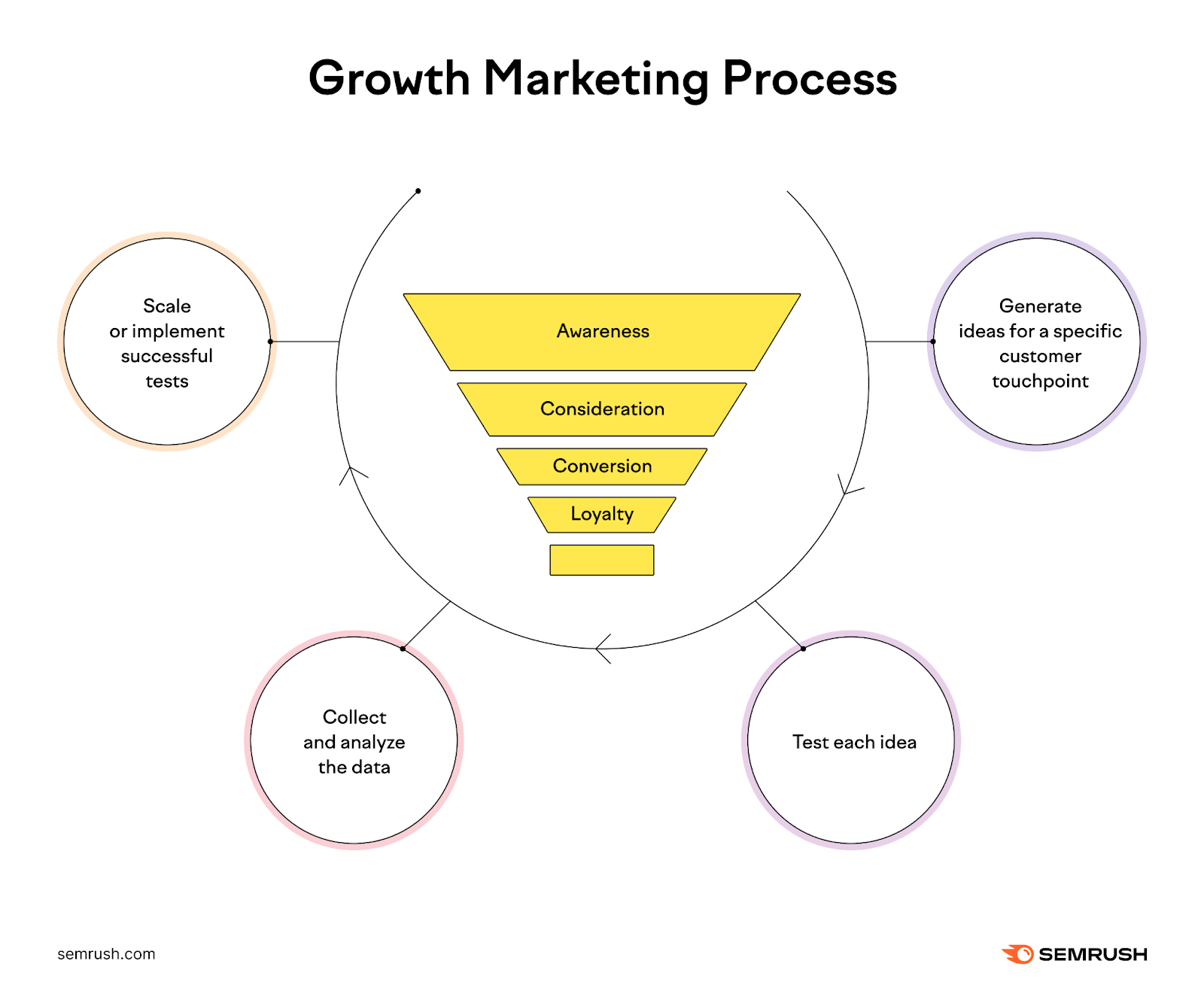
Here is an example of how you could use a growth marketing plan:
If paid search is your top-performing channel, you may want to A/B test different versions of your ad copy. To find out which one gets more clicks. You can then scale your ad spend on the copy that yields the greatest return on your investment.
You can conduct similar experiments with all the other channels and campaigns in your marketing plan. And optimize their performance.
With that, we’re done with the basics. Now, let’s learn how to write a marketing plan.
How to Create a Marketing Plan
To make it easy for you to follow along with our guide, we’ve created a brief quarterly marketing plan for a hypothetical business: Your Dream Home Consulting.
You can download this sample plan and follow along.
Let’s go over each step in detail.
1. Write a Brief Executive Summary
Start with an executive summary that outlines the main points of your marketing plan. (If you’re writing a very detailed plan, you may want to add a table of contents at the very beginning for easy navigation.)
Your executive summary should provide a quick overview of your goals, target market, main strategies, and expected outcomes.
Here’s a concise executive summary of our example plan:

If you’re writing a detailed marketing plan, your executive summary may also include details like:
- Company mission statement
- Industry and market analysis
- Leadership team
- Value proposition
- Financial plan
Further reading: Unique Value Proposition: What It Is & How to Create One
2. Set Your Marketing Goals and KPIs
Make sure your goals and KPIs align with your overall business objectives. The idea is to communicate what success looks like for your marketing plan.
Use the SMART framework for setting useful goals. It’s a great way to check whether your marketing goals are Specific, Measurable, Actionable, Relevant, and Time-bound (SMART).
This infographic explains how SMART marketing objectives relate to your overall business goals:
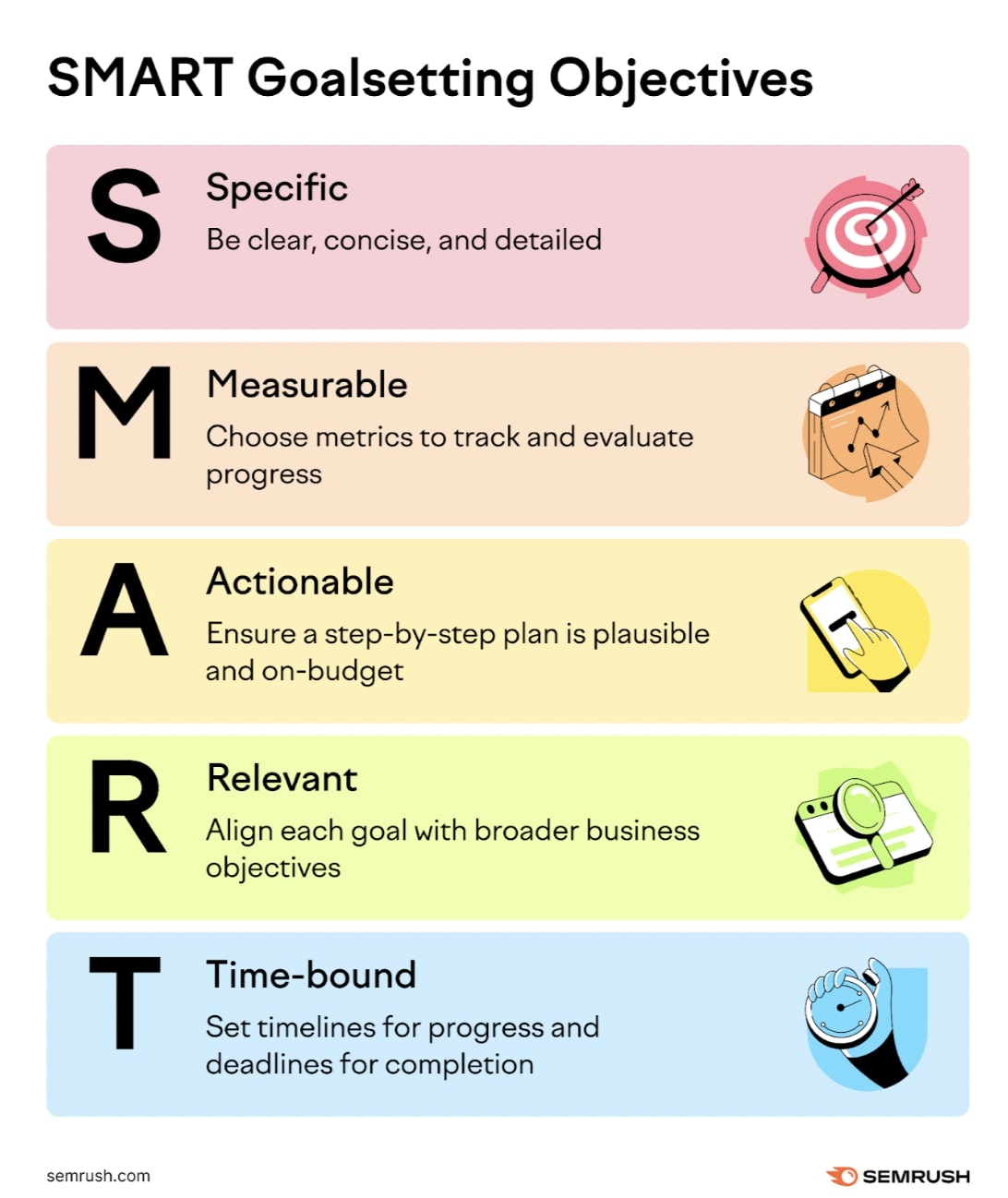
Here are some examples of SMART marketing goals:
- Increase social media engagement by 30% within six months
- Generating an extra 500 leads per month compared to last year
- Achieving a 10% increase in revenue in the next quarter
Well-defined goals will provide a clear direction for your marketing efforts.
Once you have determined your goals, establish marketing key performance indicators that tie back to your marketing goals.
Simply put, KPIs are quantifiable metrics that track the progress and effectiveness of your marketing activities.
Some common marketing KPIs include:
- Unique website visitors
- Lead generation rates
- Conversion rates
- Customer acquisition cost
- Customer lifetime value
And more.
Here are the Q4 marketing goals and KPIs of our example business, Your Dream Home Consulting.

By setting specific KPIs, you can monitor the performance of your marketing campaigns. And make data-driven decisions.
Further reading: 16 Marketing KPIs You Need to Monitor in 2024
3. Research Your Target Market and Build Buyer Personas
For your marketing plan to be effective, you must understand your target market very well. It helps you understand your target audience and create campaigns that resonate with them.
To do this, conduct thorough market research. And get answers to these questions:
- What are the demographics (like age, gender, education, and occupation) of your target audience?
- What are their interests and buying habits?
- What is their opinion of your business or industry?
- What problems can you solve for them?
- How can you best engage with them?
Here are some key market research insights for our example.

Semrush’s Market Explorer tool makes your market research process quick and easy.
Here’s how:
Let’s say you want to analyze the furniture market in the U.S.
First, open the tool and click “Analyze Category.”
Then choose the location and business category. And click the “Research a market” button.
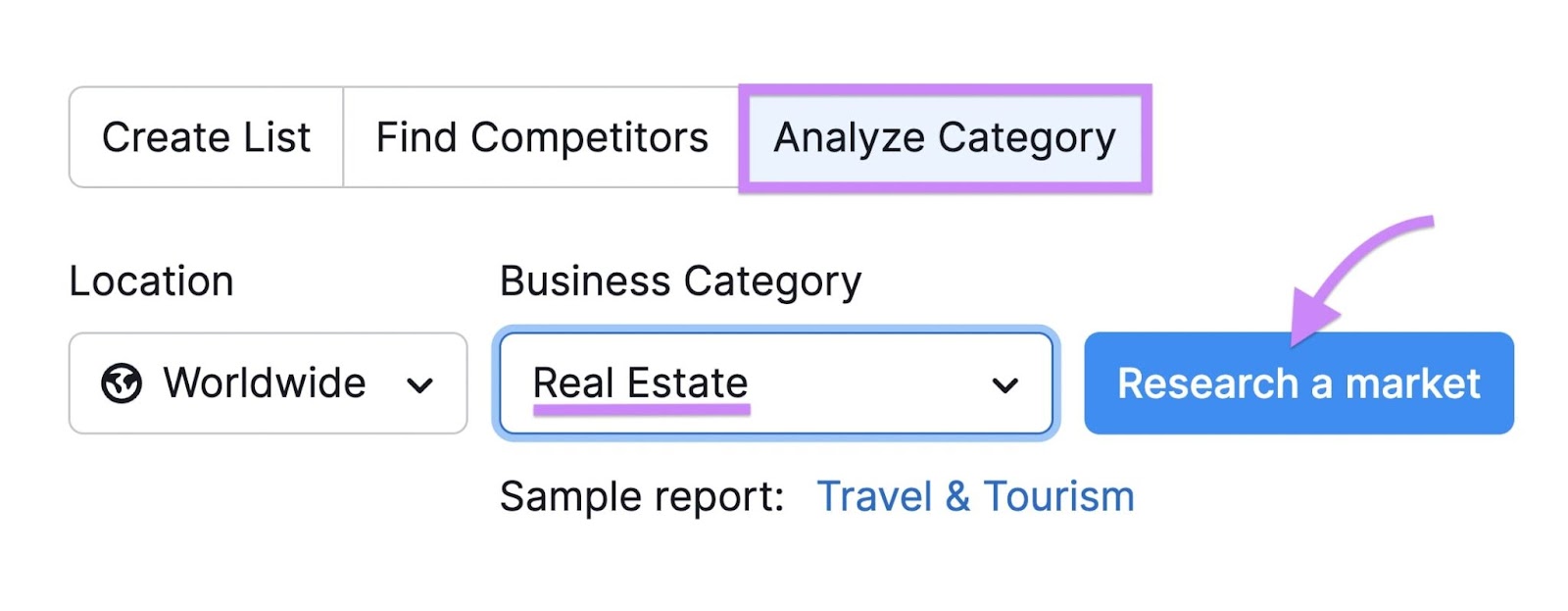
You’ll be taken to the “Overview” report.
Here, you’ll see a market summary, which provides insights like:
- Market Consolidation: The distribution of market share among companies in the market
- Key Players: Main competitors
- Market Domains: Number of websites in your market
- Market Traffic: Total monthly traffic for these domains
- Market Traffic Cost: The sum of the estimated costs of all domains in the market to rank for organic keywords over a selected period
- Market Size: A measure of the demand within your target market
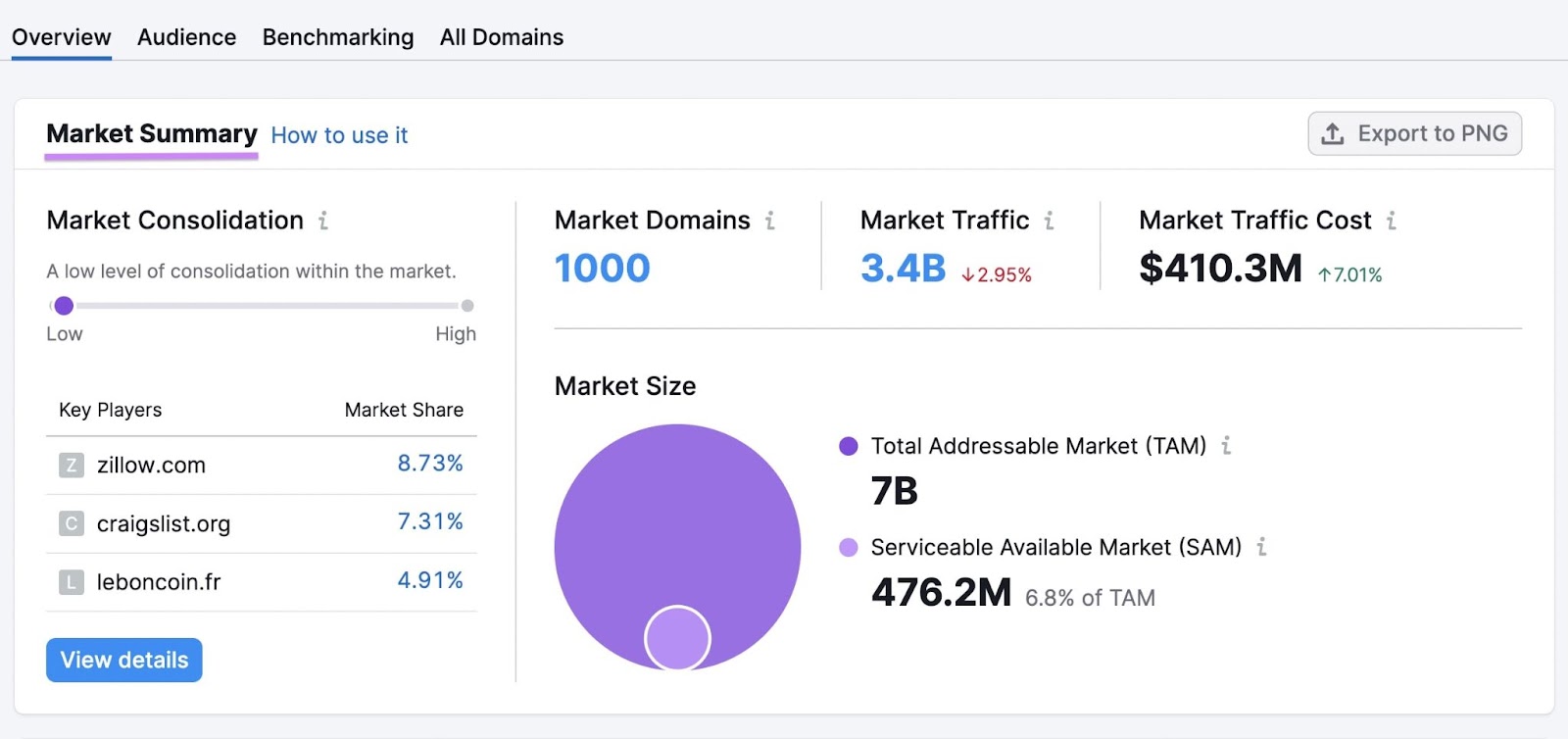
Now, click the “Audience” tab. You’ll see the “Market Audience Summary.”
It gives you a high-level overview of your target audience. And their unique attributes.
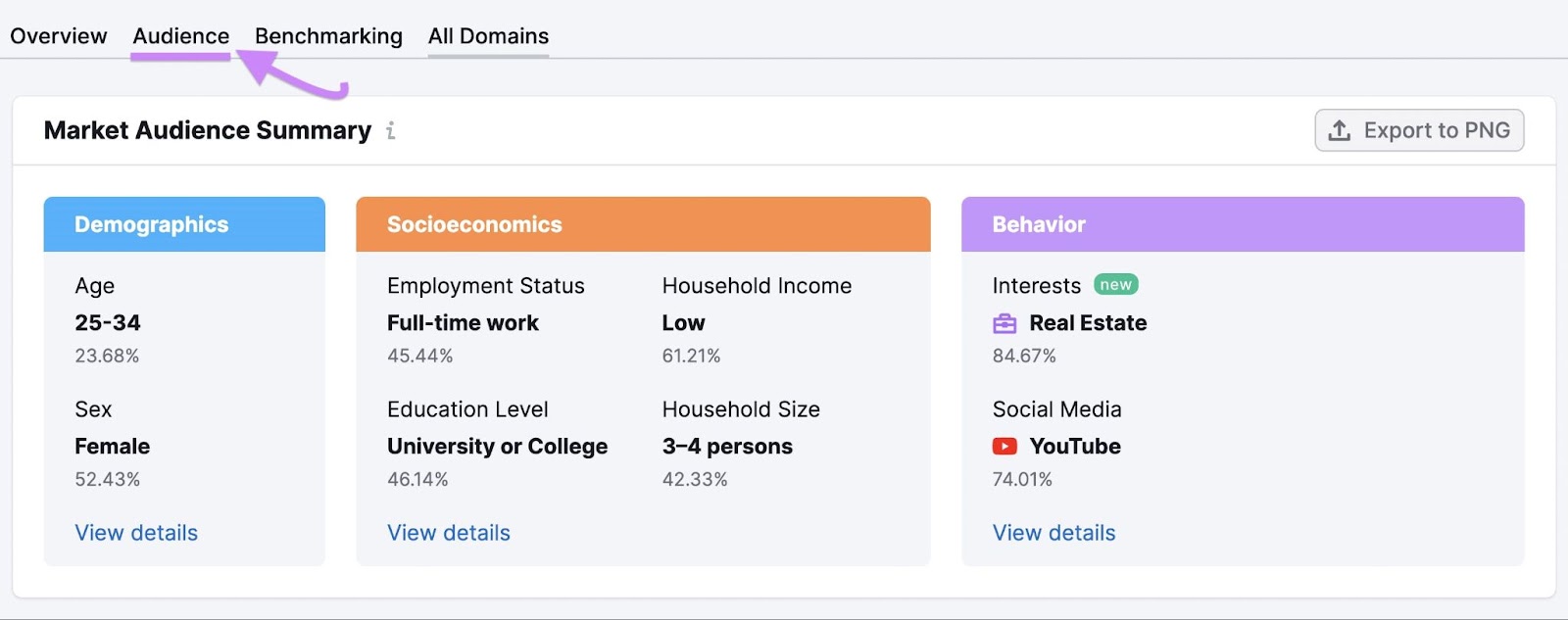
Moving further down this page, you can analyze the demographics and socioeconomic attributes of your target audience in more detail.
This information can give you a better understanding of your ideal customers. Which can help you create a more effective marketing plan.
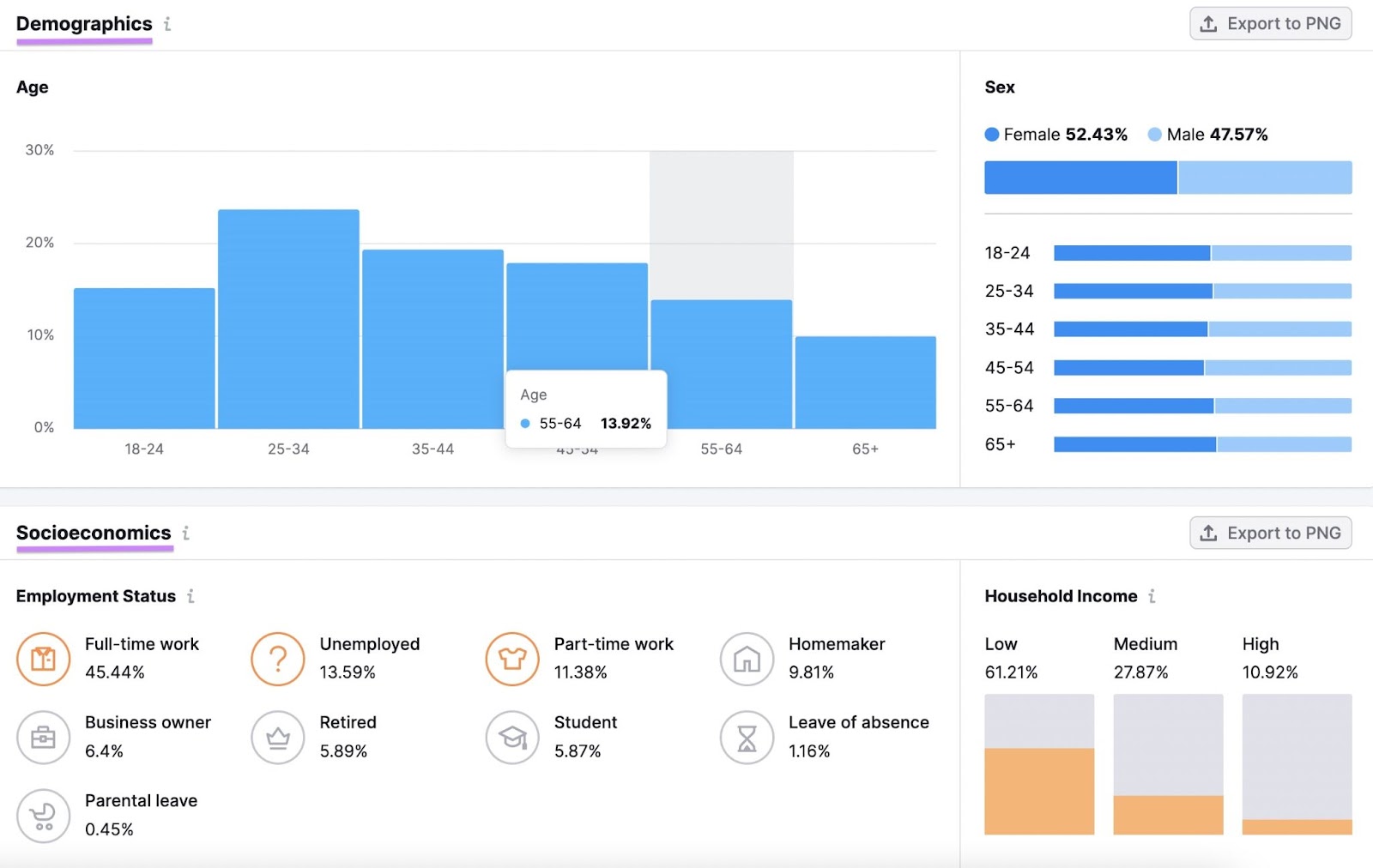
Similarly, you’ll also see their interests and the social media platforms they visit most often.
For instance, YouTube, Facebook, and Instagram are the top three social media platforms for this target audience.

This data can help you choose relevant content distribution and advertising platforms.
Once you have all these insights, create your ideal customer profile (also known as a buyer persona). So you can create relevant and personalized marketing campaigns for them.
You can use our free buyer persona templates to fill in your audience research insights that you find with Market Explorer. And create customized customer profiles.
4. Analyze Your Competitors
Competitor analysis is a crucial part of market planning. It helps you:
- Understand your competitors’ strengths and weaknesses
- Position your business with a better value proposition
- Identify gaps in the market and opportunities to differentiate your brand
So, you need to identify your main competitors. And analyze their marketing strategies, positioning, pricing, and messaging.
For this example, let’s say you want to find competitors for your website that sells men’s shaving products.
To get a quick overview of the competitive landscape, open the Market Explorer tool again.
Then click the “Find Competitors” tab. Enter your location and domain name.
And click on “Research a market.”
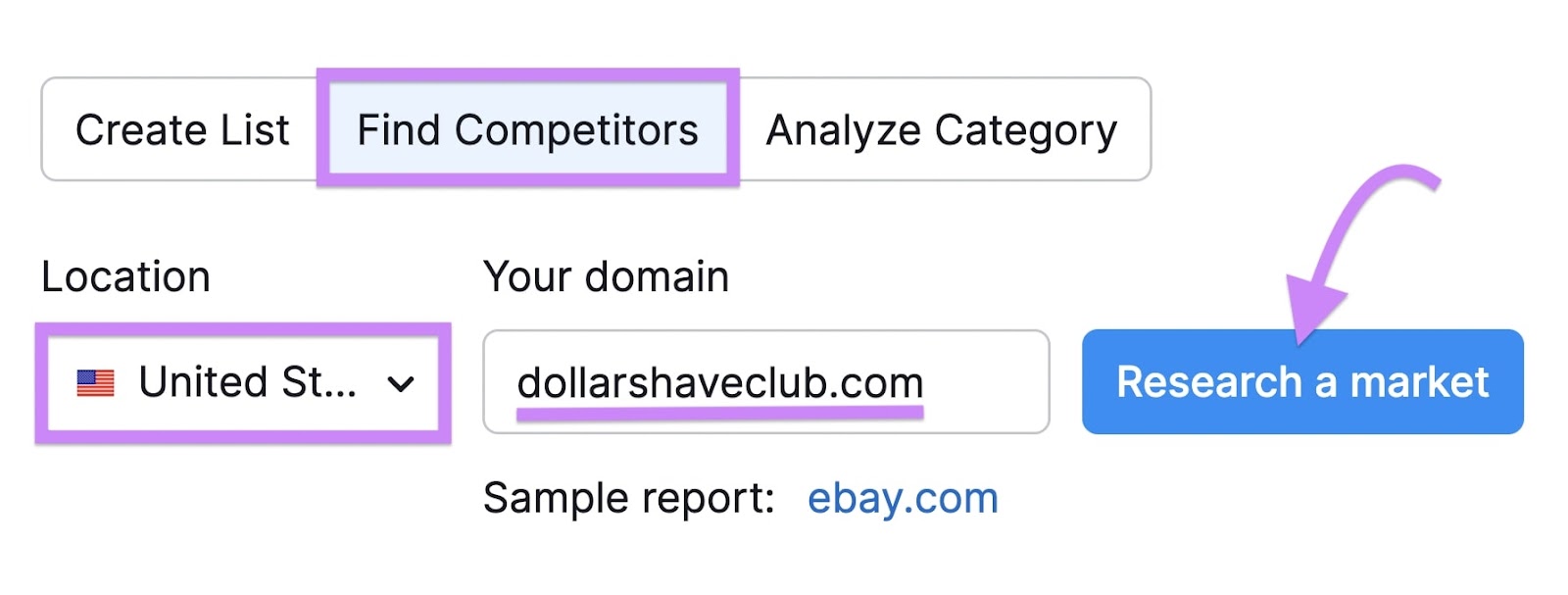
You’ll see the “Market Summary” and insights that we discussed in the previous section.
Scroll to the “Growth Quadrant” widget to visualize the competitive landscape in your market.
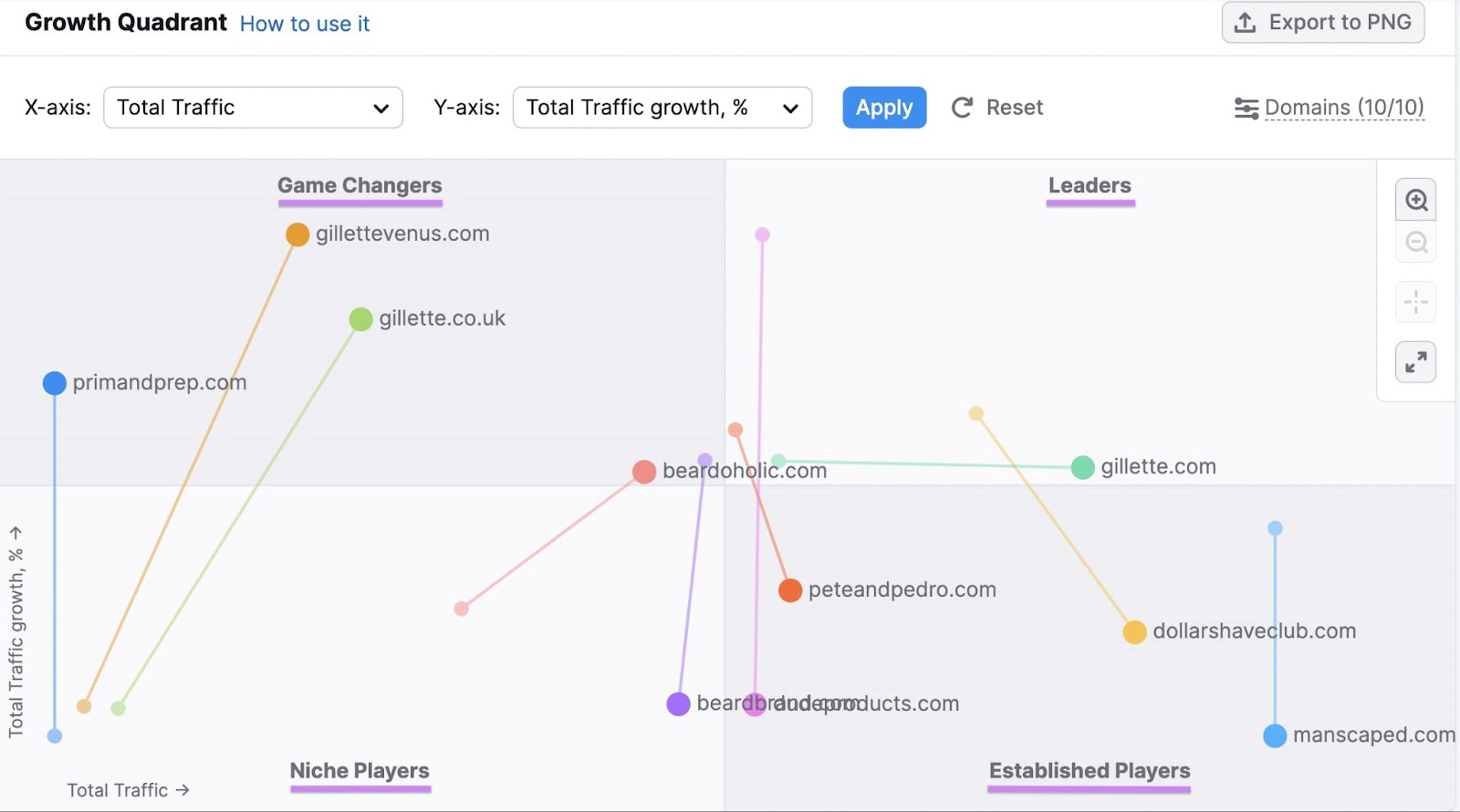
The Growth Quadrant consists of four sections:
- Game Changers: Comparatively small, but rapidly growing companies
- Leaders: Large, well-known companies with high growth rate
- Niche Players: Companies with smaller (and often very specific) audience
- Established Players: Big, popular, stable brands
Analyze where your key competitors stand. And how their traffic and audience engagement are growing compared to your site.
Read our detailed guide to competitive analysis to learn the entire process.
Once you gather information about your competitors, perform a SWOT analysis (Strengths, Weaknesses, Opportunities, and Threats) for your business. To compare how you stand in the competitive landscape.
Here are some questions you may want to consider for your SWOT analysis:
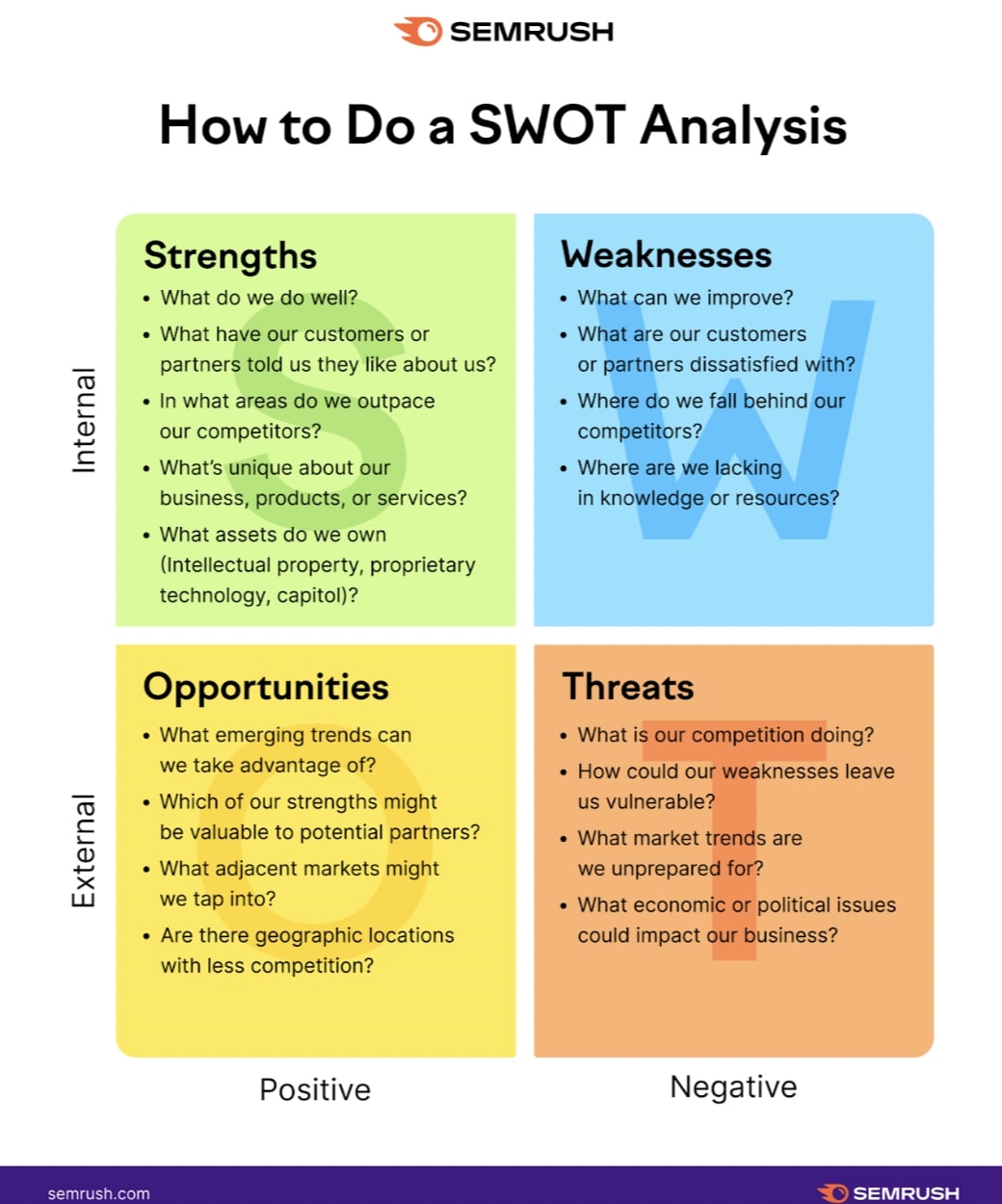
And here’s the brief competitive and SWOT analysis for our real estate consulting business example:
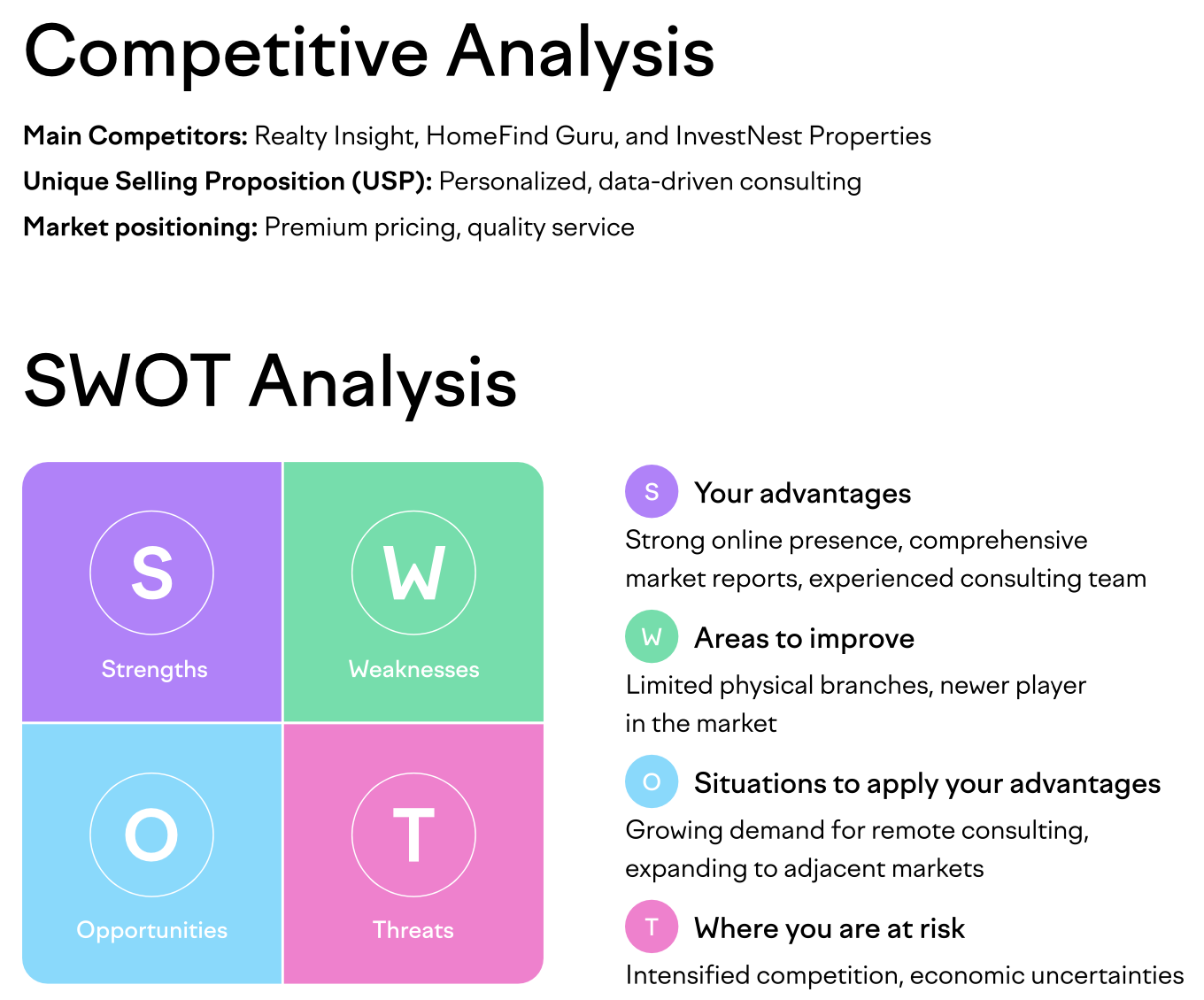
As you implement your marketing plan, you also need to keep tabs on your competitors’ marketing efforts.
You can automate this task with Semrush’s EyeOn tool.
It monitors your competitors’ online marketing activities 24/7. And sends you weekly emails about their newly published pages, blog posts, paid ads, and more.
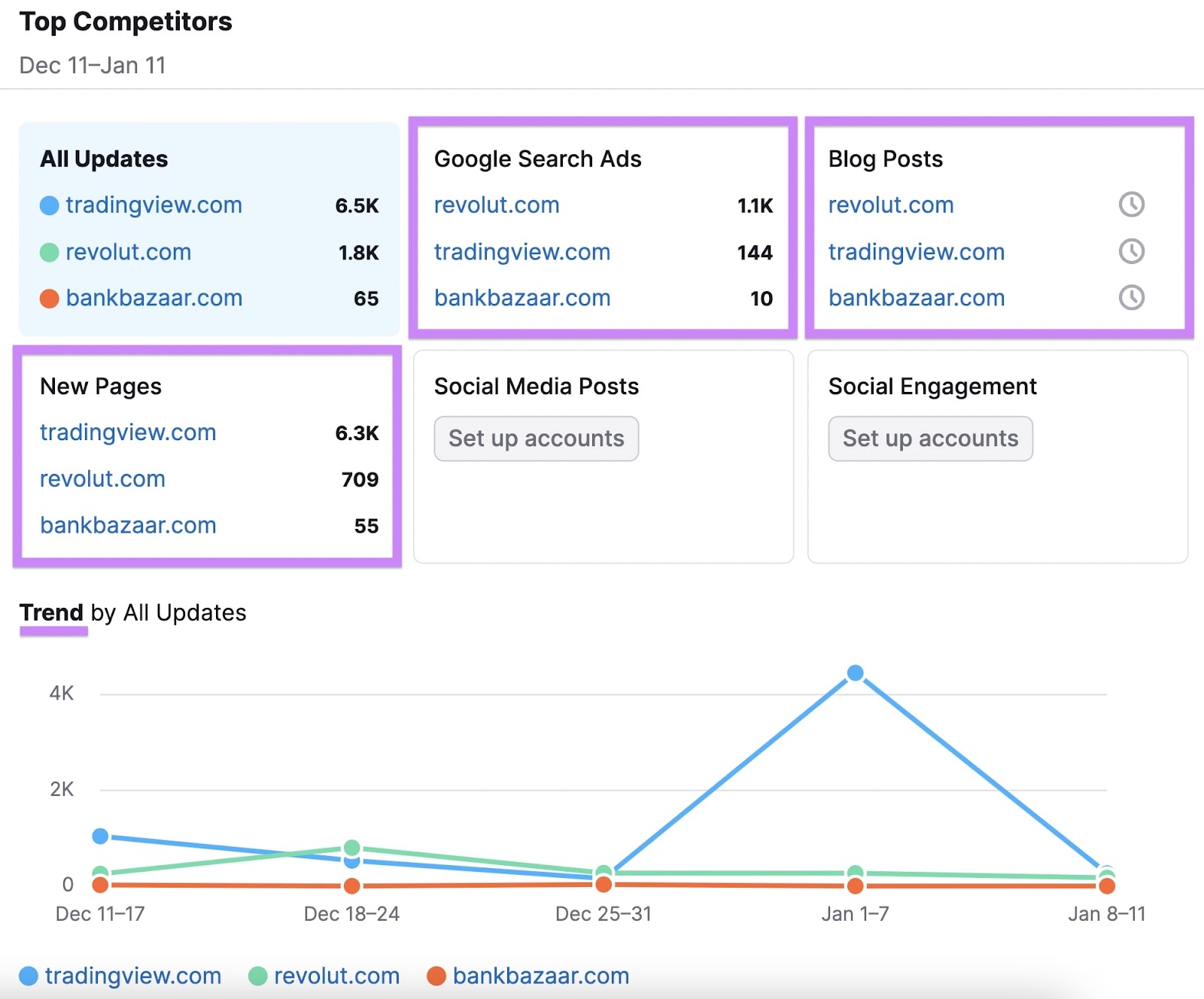
You can use this information to keep track of your main competitors and to inform your own marketing plans going forward. You can access the EyeOn tool as part of the .Trends toolkit.
5. Present Your Marketing Strategy Overview
In this step, you need to outline the key tactics and channels you will use to achieve your marketing goals.
Consider the various marketing channels available. Such as social media, content marketing, email marketing, search engine optimization (SEO), and paid advertising.
Based on your findings from the audience research stage (Step 3), determine which channels are most effective for reaching your target audience. And allocate resources accordingly.
Then create channel-specific campaigns to reach your audience.
For instance, this is how you could run the marketing campaigns for Your Dream Home Consulting. To achieve its goals in Q4.
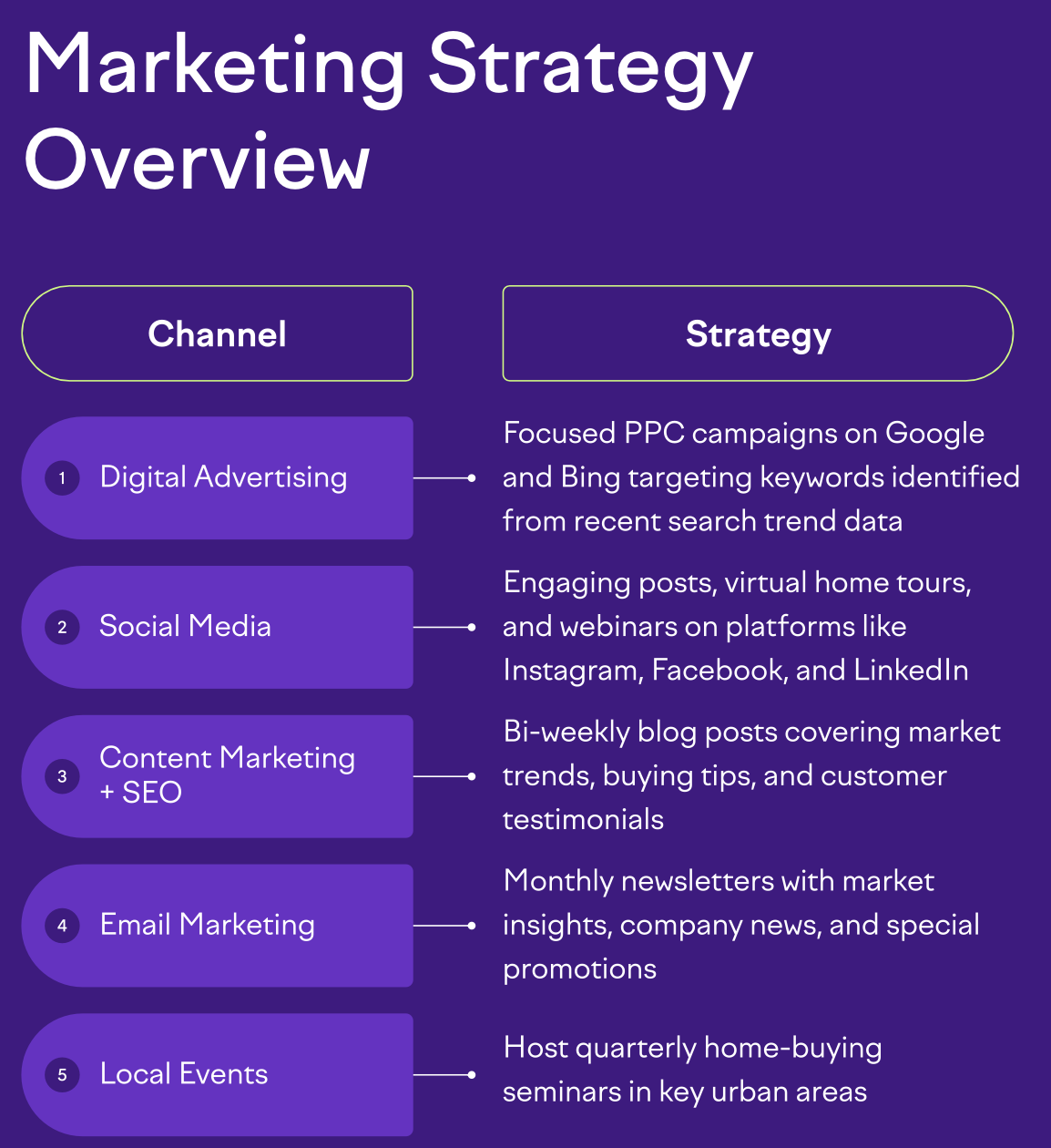
6. Define Your Marketing Budget
A well-defined marketing budget:
- Ensures your financial resources are allocated efficiently across different marketing initiatives—you’ll want to prioritize campaigns that offer the best return on investment (ROI)
- Requires you to set realistic and achievable marketing goals—based on the available financial resources
- Helps you protect profitability by preventing overspending on marketing campaigns that don’t yield results
So, how do you allocate your budget effectively?
First, consider the costs associated with various marketing channels, campaigns, and initiatives.
Then compare the costs to the expected ROI for each of them. Allocate more budget to the campaign with the highest ROI. Followed by the campaign with the second-highest ROI and so on.
However, this is a nuanced topic.
In some cases, it’s wise to assign a significant budget to a specific channel. Even if it doesn’t pay off immediately but provides high returns in the long run.
Case in point: SEO.
While pay-per-click (PPC) campaigns can generate nearly instant traffic, SEO takes time. But it builds a foundation for sustainable organic (unpaid) growth.
Over time, a strong SEO strategy can lead to consistent and long-term organic traffic. But PPC ads stop driving traffic once you stop paying for them. So it’s worth considering long-term ROI along with short-term returns.
With that, here’s the budget allocation breakdown for our example business.
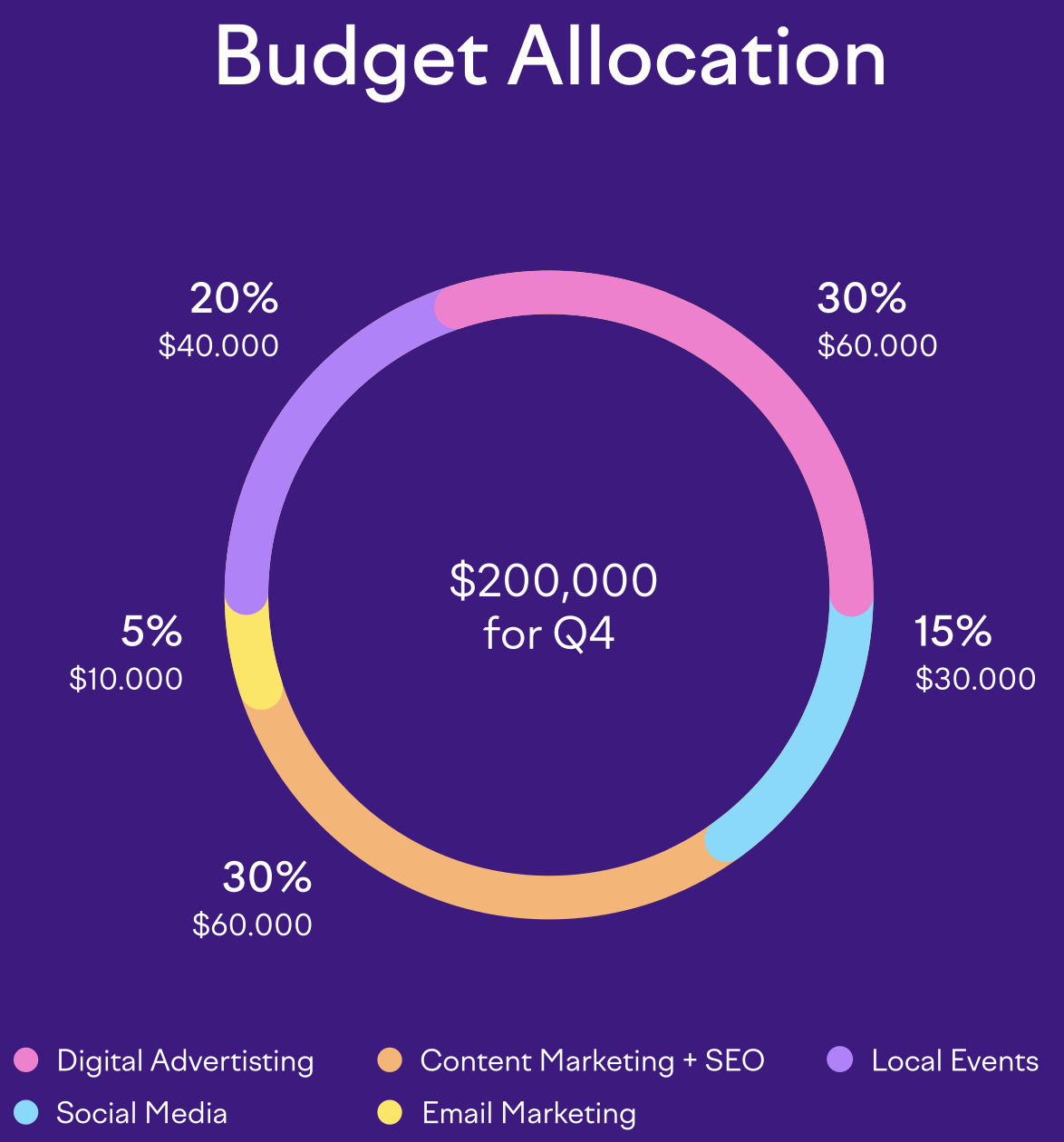
Make sure you stay flexible and adjust your budget allocation based on the performance of different channels and campaigns.
Further reading: SEO vs. PPC: What the Differences Are & When to Use Each
7. Identify Your Key Contributors
Besides the “what” and the “how,” your marketing plan should also communicate “who” will execute the plan.
This helps you:
- Get buy-in from stakeholders
- Ensure smooth execution of the plan
- Align your marketing team to work toward the shared goal
For brief marketing plans, you can just highlight different teams and leaders in charge of specific campaigns.
Like this:

And if you’re creating a more complex marketing plan, you can include additional details like:
- Campaign/project details and timelines
- Deliverables or KPIs for each team
- Detailed overview of each team member’s responsibilities
8. Establish Performance Tracking Guidelines
Conclude your marketing plan with a section about performance tracking or reporting guidelines.
Just like other sections, you can keep it concise or in-depth. Depending on how brief or detailed your marketing plan is.
However, it’s important to set some straightforward tracking criteria.
At a minimum, you should include:
- The metrics or KPIs you’re planning to track
- Your tracking approach
- Tracking frequency
For instance, here’s a simple performance tracking plan in our example:
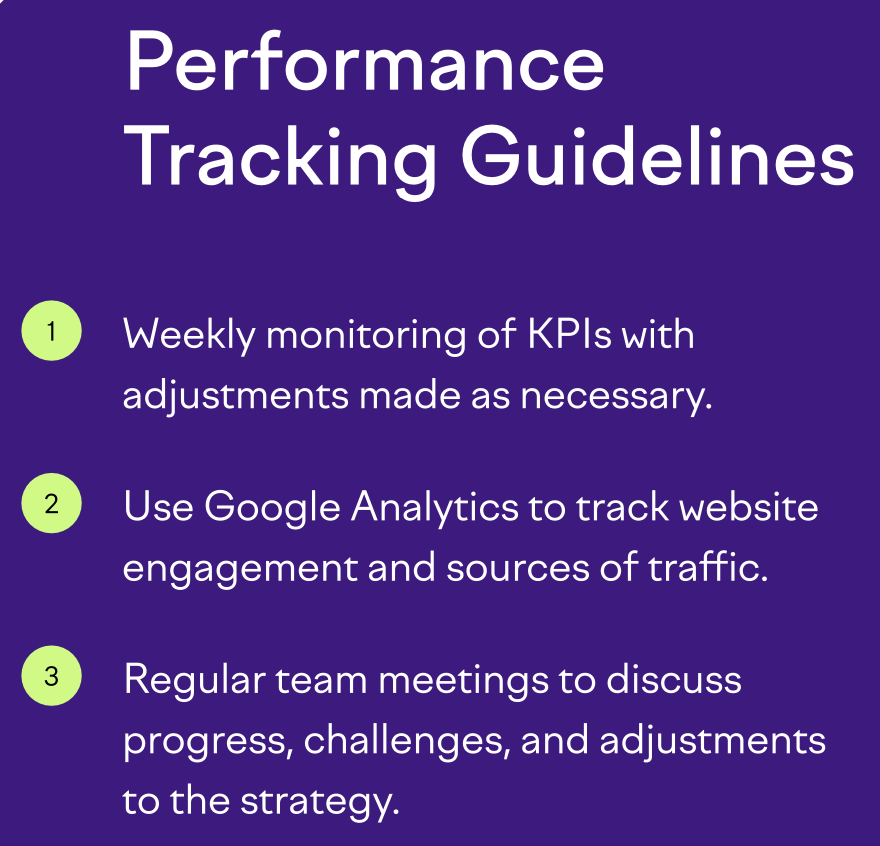
Regularly review these metrics, analyze trends, and make adjustments to your marketing strategies as needed.
You can automate your performance tracking using Semrush’s My Reports tool.
Here’s how:
Say you want to create a KPI report for tracking the progress of your goal to grow your organic traffic.
Select one of the ready-to-use templates. Or click “Create report” to build a custom report.
We’ll go ahead with a custom report.
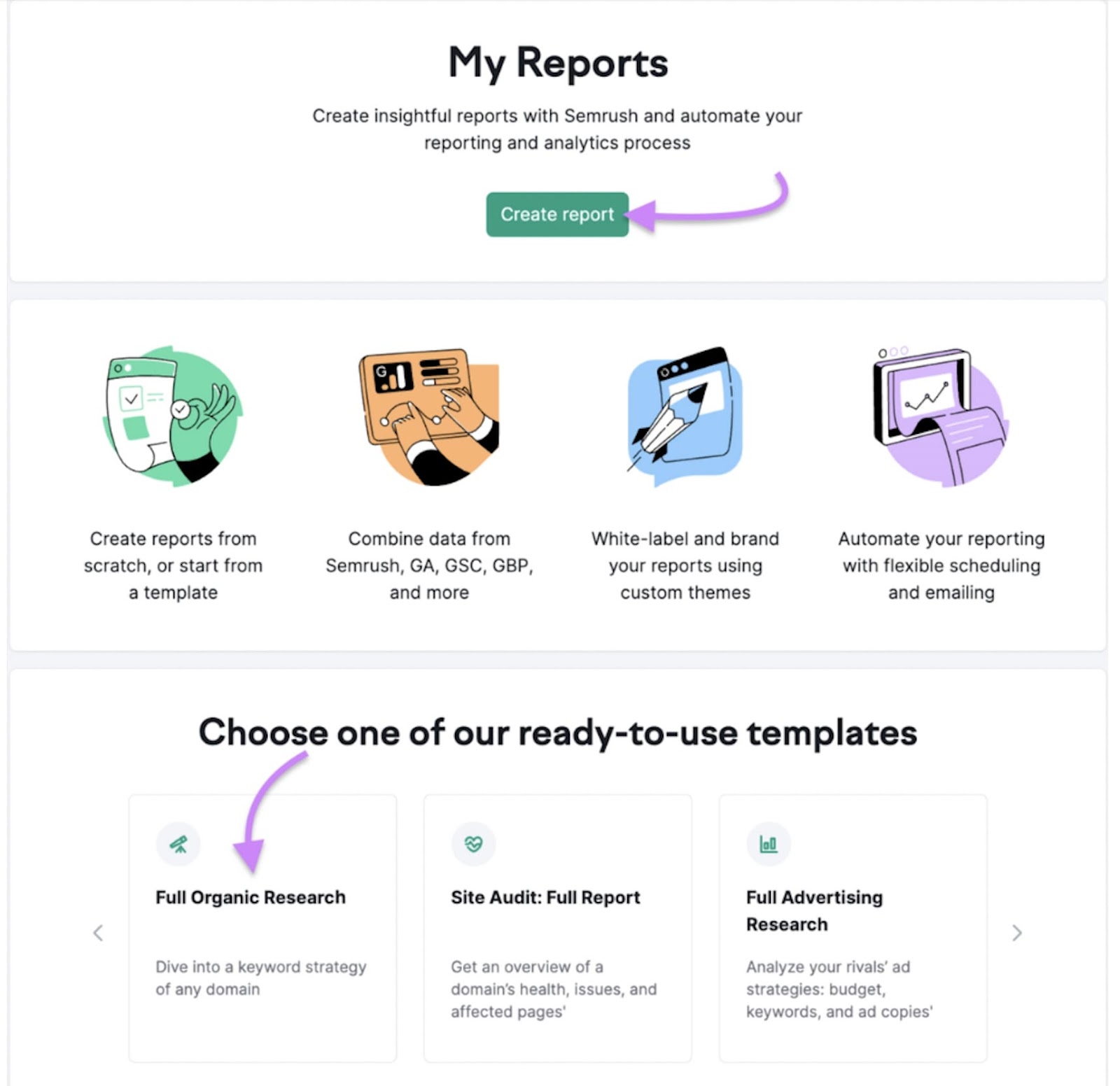
You’ll see a list of widgets on the left panel.
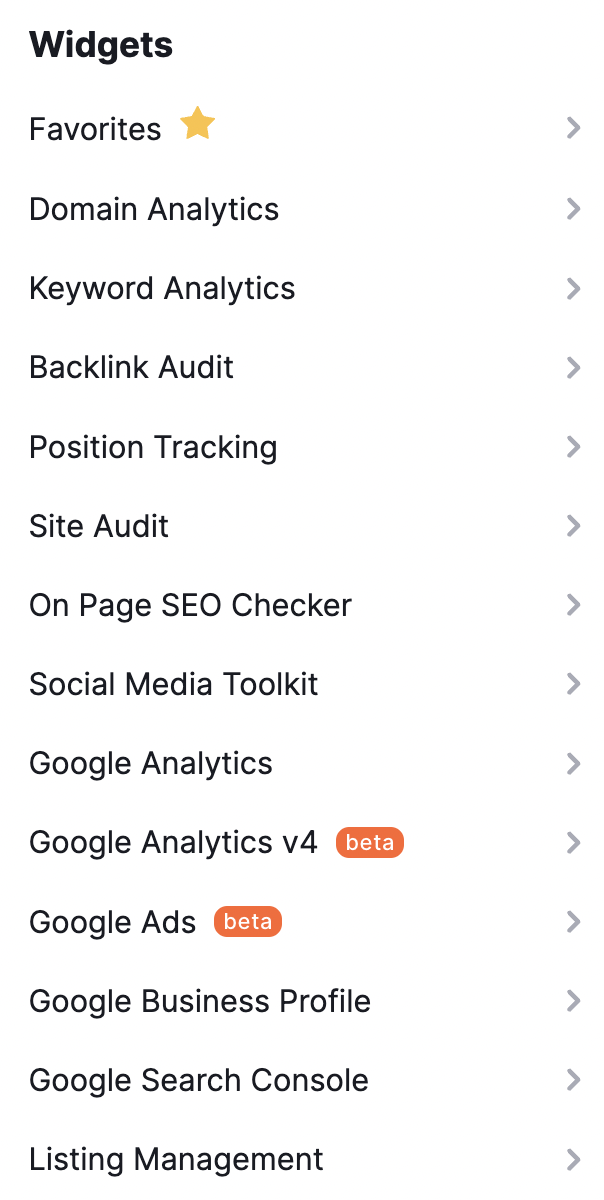
Go to “Domain Analytics” > “Organic research.”
Drag and drop the relevant metrics into the report on the right.
Like this:
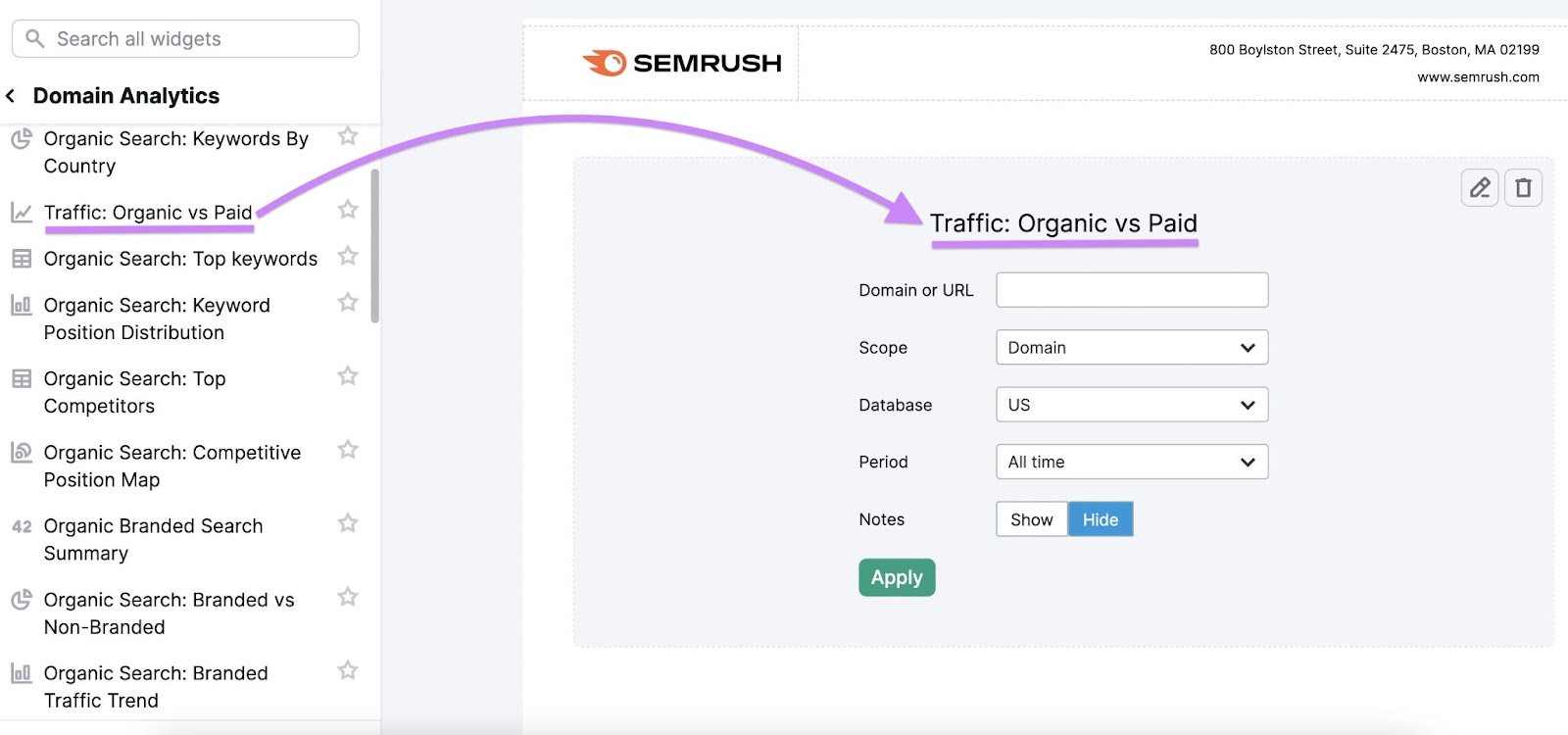
Drag and drop all the metrics you want to track. And set your goals or thresholds.
That’s it. Your automated KPI tracker is ready.
Marketing Plan Outline
In the last section, we learned how to create a brief marketing plan.
However, you may want to add more information to make it easier for key players in your business to follow your marketing plan.
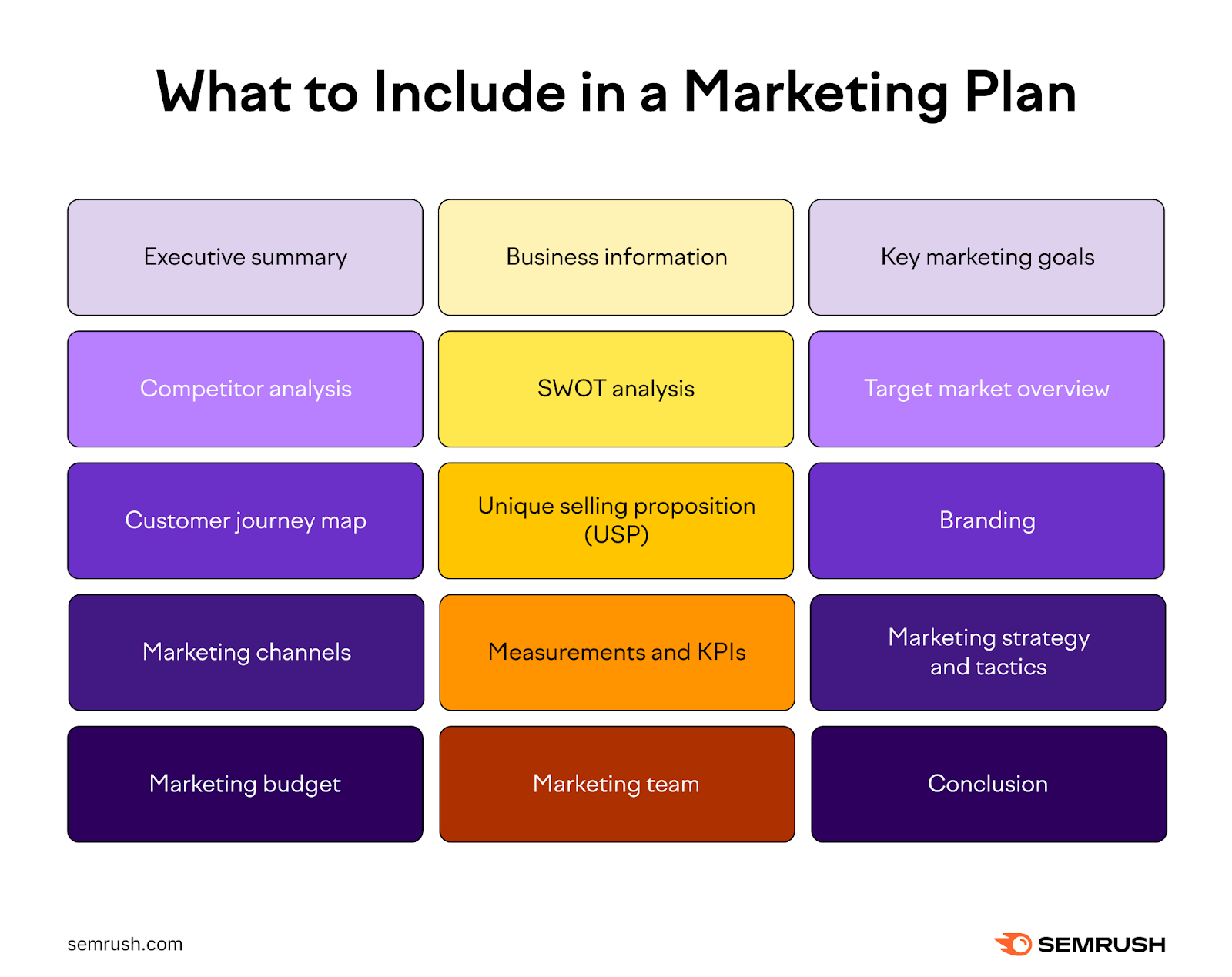
If you want to create a comprehensive and detailed marketing plan, follow this outline:
- Executive summary: One or two-page summary giving an overview of your marketing plan
- Business information: Key points about your brand, mission statement, and business goals
- Key marketing goals: Detailed discussion of your marketing goals and how they align with overall business objectives
- Competitor analysis: Main findings of your competitive research (Step 4 above)—their marketing channels, traffic sources, successful products, top webpages, paid ads, etc.
- SWOT analysis: Detailed SWOT analysis of your business
- Target market overview: Market size, opportunities, limitations, and market consolidation—you can use the Market Explorer tool for this
- Customer journey map: Analysis of the customer journey in your sales funnel, including the sources/channels of lead generation
- Unique selling proposition (USP): What sets your brand apart from your competitors?
- Branding: How is your brand currently perceived? How would you like it to be perceived?
- Marketing channels: The platforms you’re planning to use—have goals and action items for each of them
- Measurements and KPIs: How will you track the performance of your marketing plan?
- Marketing strategy and tactics: Tactics and techniques you’ll use to achieve your marketing goals
- Marketing budget: Budget allocation by channel—include reasons if you’re investing more in specific channels
- Marketing team: Details like key people, responsibilities, and deliverables
- Conclusion: Summary of the plan and reiteration of the main objectives
Let’s look at some examples of marketing plans to see all of this in action.
3 Great Marketing Plan Examples
1. University of Illinois
In 2021, the University of Illinois created an in-depth marketing plan to boost its undergraduate admissions.
This plan is made up of three main sections:
- Section 1: Explains overall context, admission funnel, target segments, and student demographics
- Section 2: Mainly talks about the market and audience research process
- Section 3: Details strategies/tactics for achieving goals and success metrics
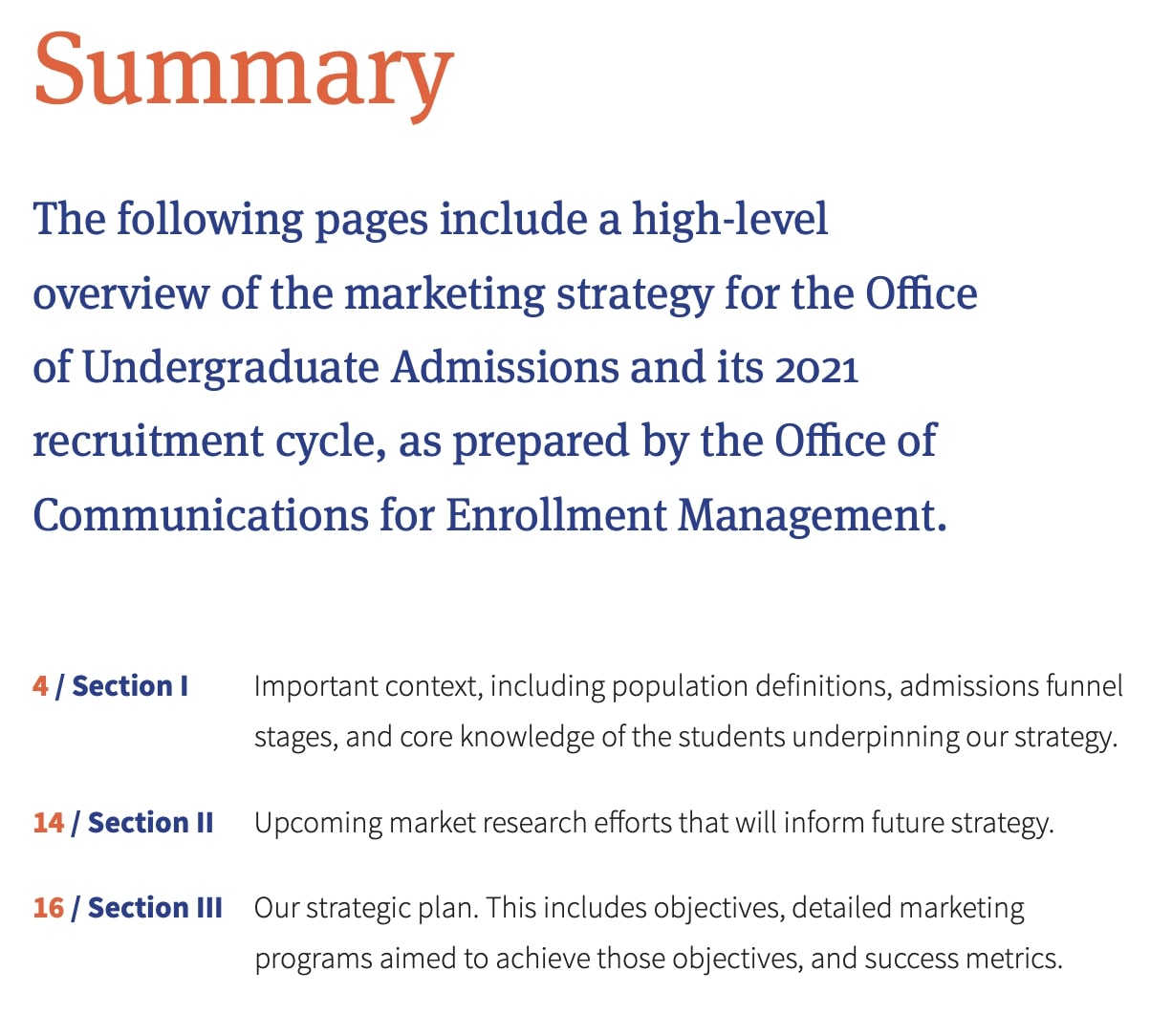
Image Source: University of Illinois
Why This Is a Good Example
- Demonstrates a thorough understanding of different audience segments. Such as prospects, inquiries, applicants, and admitted students. This helps in creating tailored marketing campaigns for maximum impact.
- Clearly outlines objectives, tactics, and metrics for each marketing channel. Such as content marketing, digital ads, direct mail, and email. This clarity helps in the efficient execution and monitoring of the marketing plan.
- Emphasizes building brand awareness and trust. Which are crucial for long-term engagement and reputation management (especially for a university).
2. The City of West Chicago
To reinvent its identity, the City of West Chicago created a strategic marketing plan.
It’s a good marketing plan example to follow if you’re planning to rebrand your business.

Image Source: The City of West Chicago
Why This Is a Good Example
- Acknowledges both challenges (like an outdated reputation) and opportunities (increasing diversity). As a result, they set realistic goals.
- Includes research on successful marketing strategies and best practices of other cities
- Comprehensive SWOT analysis
- Identifies key demographic segments such as the Latino and Caucasian populations. And outlines tailored communication strategies for each.
3. Safe Haven Family Shelter
Check this 2022 Marketing Plan from non-profit organization: Safe Haven Family Shelter.
It’s comprehensive and well-organized. And there is a lot you could apply to your own business’s marketing plan.
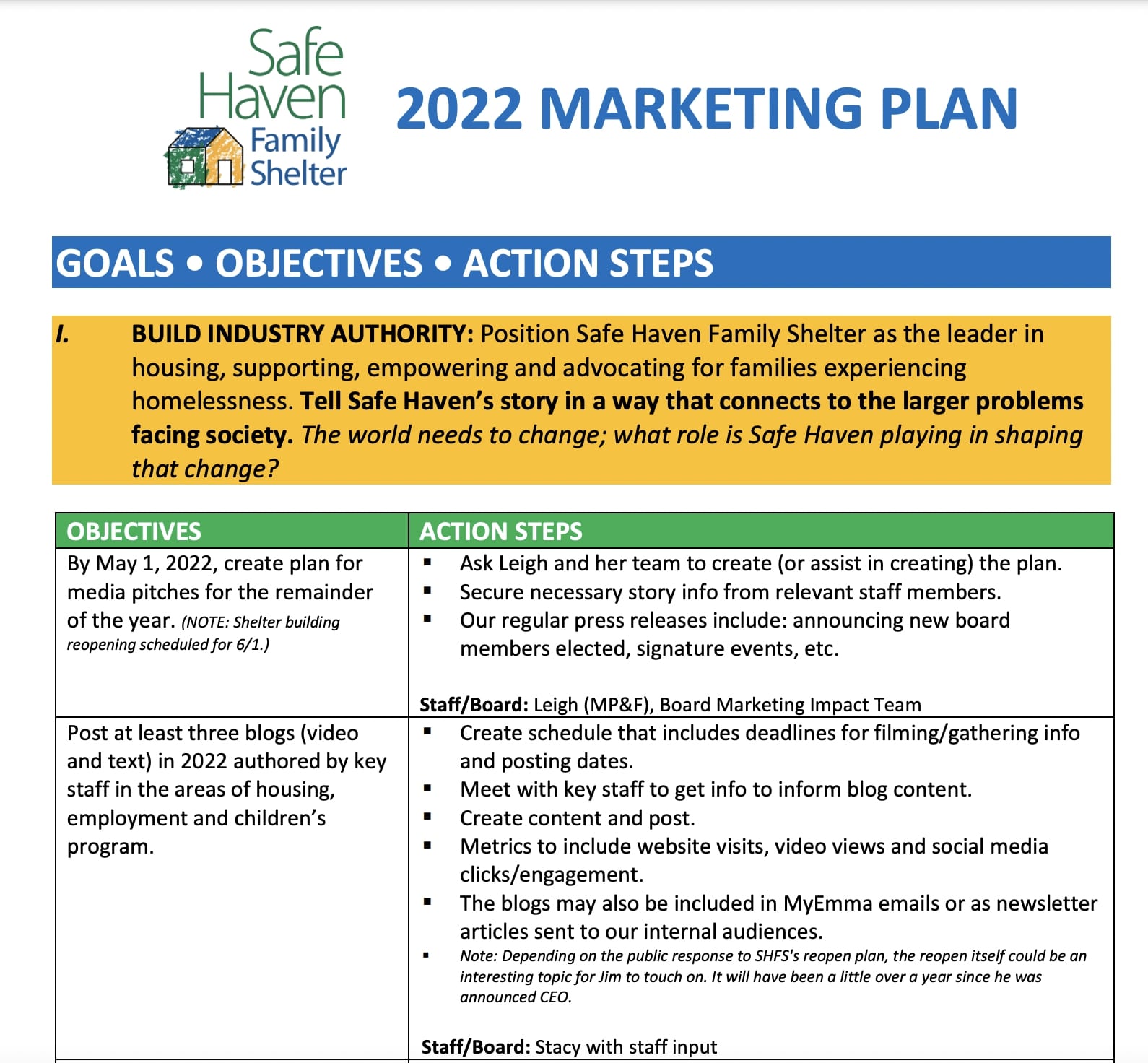
Image Source: Safe Haven Family Shelter
Why This Is a Good Example
- Uses a simple and easy-to-follow structure, with tables and bullet points
- Clearly communicates four main goals: building industry authority, brand awareness, brand loyalty in established audiences, and event & fundraising campaign brands
- For each objective, the plan outlines detailed action items. And assigns specific staff or board members to monitor these tasks. Such in-depth planning ensures accountability and effective execution.
- Also talks about longer-term objectives. This indicates a commitment to sustained growth and development.
Create a Research-Driven Marketing Plan for Long-Term Success
Marketing plans are not meant to be set in stone. Keep them flexible and adaptable based on your goals and marketing platforms.
And keep fine-tuning your marketing plan as the dynamics of your business change.
The success of your marketing plan depends on how well you understand your market. And potential customers.
Use Semrush’s Market Explorer tool to get valuable insights about your industry, target audience, and competitors. And create a well-researched, effective marketing plan for your business.
Source link : Semrush.com
